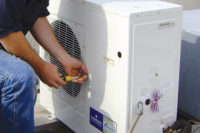Remember that these load calculations are only estimates. The actual load requirements for a particular walk-in cooler or freezer may differ.
Most load calculations for any walk-in cooler or freezer are based on four separate loads, including:
1. Heat transmission — heat gained through the walls, floors, and ceiling of a walk-in structure;
2. Air infiltration — heat gained due to the air entering the structure;
3. Product load — heat removed from a product to cool it from one temperature to a lower temperature; it also includes the heat of respiration from some fruits and vegetables; and
4. Supplemental loads — heat dissipated by people or mechanical equipment in the walk-in.
The person sizing a walk-in cooler or freezer must understand the application and environment in which the walk-in will be used. There are several situations where a person relying on the sizing chart alone could miscalculate the actual load for the walk-in.
If, for example, the walk-ins were to be located outdoors rather than indoors, the heat gain through transmission would be much greater in the hot days of summer than normally accounted for in many sizing charts. The size of the refrigeration equipment may need to be increased to satisfy this additional load.
A person sizing a walk-in cooler or freezer should ask these two important questions:
1. Where is the walk-in going to be installed?
2. What will the maximum ambient temperature be outside of the box?
PRODUCTS
Other important questions to ask concern the product going into the walk-in:Again, most charts are based on averages. If the temperature of the product entering the walk-in is higher than normal, or if an unusual amount of product will be stored in the walk-in, the capacity of the refrigeration equipment may need to be increased. Another potential problem with using generic sizing charts is with supplemental loads. If the supplemental load is higher than the averages, the capacity as listed on a generic chart may need to be increased. For example, if many people will be working in the cooler, or if some type of major equipment will be running in the walk-in on a consistent basis, the load may need to be increased.
Any person sizing walk-in coolers and freezers should determine if a particular application falls outside the loads as stated on the charts, and if a complete load calculation needs to be done.
Marchese is owner of Coldtronics, Pittsburgh, PA; 412-734-4433; www.coldtronics.com (website); joe@coldtronics.com (e-mail).
Publication date: 06/03/2002





